What Is The Chemical Makeup Of Eath's Atmosphere During The Paleogene

Typical vegetation from the Paleogene period
Press release issued: thirty July 2018
A new written report led by scientists at the University of Bristol has warned that unless we mitigate current levels of carbon dioxide emissions, Western Europe and New Zealand could revert to the hot tropical climate of the early on Paleogene period – 56-48 one thousand thousand years ago.
As seen from the ongoing oestrus wave, the knock-on furnishings of such farthermost warmth include arid land and fires as well as impacts on health and infrastructure.
The early Paleogene is a period of great interest to climate modify scientists every bit carbon dioxide levels (effectually ane,000 ppmv) are similar to those predicted for the end of this century.
Dr David Naafs from the University of Bristol'south Schoolhouse of Earth Sciences, led the research published today in the journal, Nature Geoscience.
He said: "We know that the early Paleogene was characterised past a greenhouse climate with elevated carbon dioxide levels.
"Most of the existing estimates of temperatures from this period are from the ocean, not the land - what this study attempts to answer is exactly how warm it got on land during this catamenia."
Scientists used molecular fossils of microorganisms in aboriginal peat (lignite) to provide estimates of land temperature 50 million-years ago.
This demonstrated that annual land temperatures in Western Europe too as New Zealand were actually higher than previously thought - betwixt 23 and 29 °C – this is currently 10 to xv °C higher than electric current average temperatures in these areas.
These results suggest that temperatures like to those of the current heat moving ridge that is influencing western Europe and other regions would become the new norm past the end of this century if CO2 levels in the temper continue to increase.
Professor Rich Pancost, Co-author and Director of the University of Bristol Cabot Institute, added: "Our work adds to the evidence for a very hot climate nether potential end-of-century carbon dioxide levels.
"Chiefly, we also study how the Earth system responded to that warmth. For example, this and other hot fourth dimension periods were associated with evidence for barren atmospheric condition and farthermost rainfall events."
The inquiry team will now turn their attentions to geographical areas in lower-latitudes to see how hot land temperatures were at that place.
Dr Naafs said: "Did the torrid zone, for example, become ecological expressionless zones because temperatures in backlog of 40 °C were besides high for most form of life to survive?
"Some climate models suggest this, but nosotros currently lack critical information.
"Our results hint at the possibility that the tropics, like the mid-latitudes, were hotter than present, but more work is needed to quantify temperatures from these regions."
Farther data
Newspaper:
'High temperatures in the terrestrial mid-latitudes during the early Palaeogene' past B. D. A. Naafs, M. Rohrssen, G. N. Inglis, O. Lähteenoja, S. J. Feakins, K. E. Collinson, E. M. Kennedy, P. K. Singh, Thou. P. Singh, D. J. Lunt and R. D. Pancost in Nature Geoscience
The Cabot Establish
The Cabot Establish carries out fundamental and responsive inquiry on risks and uncertainties in a changing environment. We drive new inquiry in the interconnected areas of climate change, natural hazards, water and nutrient security, low carbon free energy, and futurity cities. Our research fuses rigorous statistical and numerical modelling with a deep understanding of social, environmental and engineered systems – by, present and future. We seek to appoint wider club by listening to, exploring with, and challenging our stakeholders to develop a shared response to 21st Century challenges. Find out more than about our piece of work at www.bristol.ac.britain/cabot
The Organic Geochemistry Unit of measurement
The OGU was founded in 1968 and since then has been at the forefront in the investigation of organic affair in organisms, soils, sediments and rocks. The group was the first to look for evidence of organic thing in the Apollo xi lunar rocks, pioneered the field of archaeological chemistry and created numerous new tools for reconstructing Earth's climate history. Find out more about our piece of work at http://www.bristol.air-conditioning.uk/chemistry/research/ogu/
TGRES
The Greenhouse Globe System Research grant was awarded past the European Research Council to University of Bristol Cabot Institute scientists Rich Pancost (PI), Dan Lunt, Paul Valdes, Heather Buss, David Naafs and Richard Evershed. The aims of the projection are to develop new molecular proxies – especially for environmental processes that remain poorly understood – and apply them to past warm climates. Simultaneously, the project is adapting the most recent climate modelling advances and applying them to ancient climates. The project has been informed by the Uncertain World conversations during Bristol's year as the European Green Capital, facilitating linkages between our understanding of ancient climates and the needs of cities and nations.
Bridge
Bristol Inquiry Initiative for the Dynamic Global Environment (BRIDGE) is conveying out research centred on understanding the past, nowadays, and future Earth system, with a focus on climate and biogeochemical modelling, and geochemistry.
What Is The Chemical Makeup Of Eath's Atmosphere During The Paleogene,
Source: https://www.bristol.ac.uk/news/2018/july/co2-levels-paleogene-period.html
Posted by: crossdrettemy.blogspot.com


0 Response to "What Is The Chemical Makeup Of Eath's Atmosphere During The Paleogene"
Post a Comment